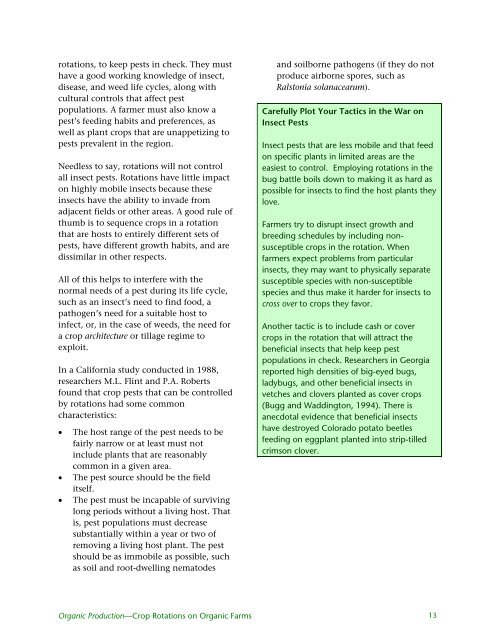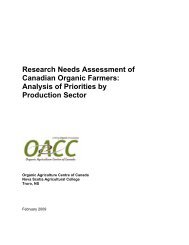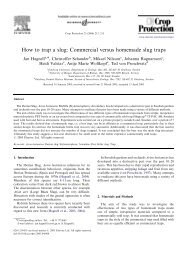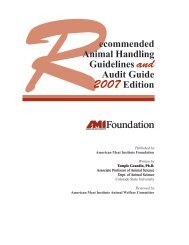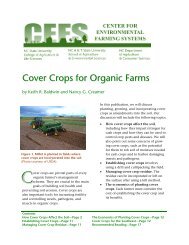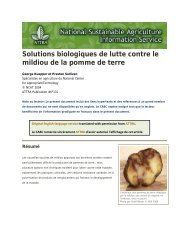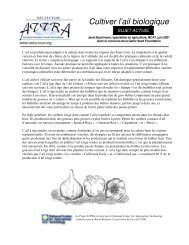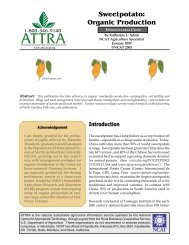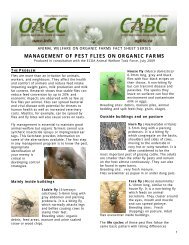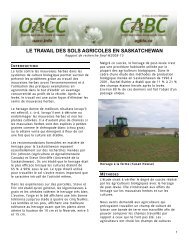Create successful ePaper yourself
Turn your PDF publications into a flip-book with our unique Google optimized e-Paper software.
otati<strong>on</strong>s, to keep pests in check. They musthave a good working knowledge of insect,disease, and weed life cycles, al<strong>on</strong>g withcultural c<strong>on</strong>trols that affect pestpopulati<strong>on</strong>s. A farmer must also know apest’s feeding habits and preferences, aswell as plant crops that are unappetizing topests prevalent in the regi<strong>on</strong>.Needless to say, rotati<strong>on</strong>s will not c<strong>on</strong>trolall insect pests. <str<strong>on</strong>g>Rotati<strong>on</strong>s</str<strong>on</strong>g> have little impact<strong>on</strong> highly mobile insects because theseinsects have the ability to invade fromadjacent fields or other areas. A good rule ofthumb is to sequence crops in a rotati<strong>on</strong>that are hosts to entirely different sets ofpests, have different growth habits, and aredissimilar in other respects.All of this helps to interfere with thenormal needs of a pest during its life cycle,such as an insect’s need to find food, apathogen’s need for a suitable host toinfect, or, in the case of weeds, the need fora crop architecture or tillage regime toexploit.In a California study c<strong>on</strong>ducted in 1988,researchers M.L. Flint and P.A. Robertsfound that crop pests that can be c<strong>on</strong>trolledby rotati<strong>on</strong>s had some comm<strong>on</strong>characteristics:• The host range of the pest needs to befairly narrow or at least must notinclude plants that are reas<strong>on</strong>ablycomm<strong>on</strong> in a given area.• The pest source should be the fielditself.• The pest must be incapable of survivingl<strong>on</strong>g periods without a living host. Thatis, pest populati<strong>on</strong>s must decreasesubstantially within a year or two ofremoving a living host plant. The pestshould be as immobile as possible, suchas soil and root-dwelling nematodesand soilborne pathogens (if they do notproduce airborne spores, such asRalst<strong>on</strong>ia solanacearum).Carefully Plot Your Tactics in the War <strong>on</strong>Insect PestsInsect pests that are less mobile and that feed<strong>on</strong> specific plants in limited areas are theeasiest to c<strong>on</strong>trol. Employing rotati<strong>on</strong>s in thebug battle boils down to making it as hard aspossible for insects to find the host plants theylove.Farmers try to disrupt insect growth andbreeding schedules by including n<strong>on</strong>susceptiblecrops in the rotati<strong>on</strong>. Whenfarmers expect problems from particularinsects, they may want to physically separatesusceptible species with n<strong>on</strong>-susceptiblespecies and thus make it harder for insects tocross over to crops they favor.Another tactic is to include cash or covercrops in the rotati<strong>on</strong> that will attract thebeneficial insects that help keep pestpopulati<strong>on</strong>s in check. Researchers in Georgiareported high densities of big-eyed bugs,ladybugs, and other beneficial insects invetches and clovers planted as cover crops(Bugg and Waddingt<strong>on</strong>, 1994). There isanecdotal evidence that beneficial insectshave destroyed Colorado potato beetlesfeeding <strong>on</strong> eggplant planted into strip-tilledcrims<strong>on</strong> clover.<strong>Organic</strong> Producti<strong>on</strong>—<str<strong>on</strong>g>Crop</str<strong>on</strong>g> <str<strong>on</strong>g>Rotati<strong>on</strong>s</str<strong>on</strong>g> <strong>on</strong> <strong>Organic</strong> <strong>Farms</strong> 13


